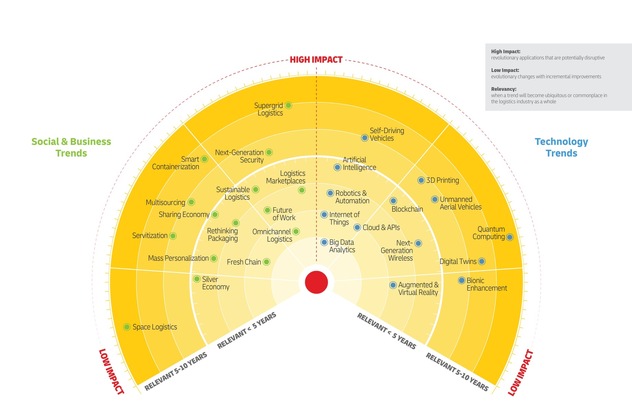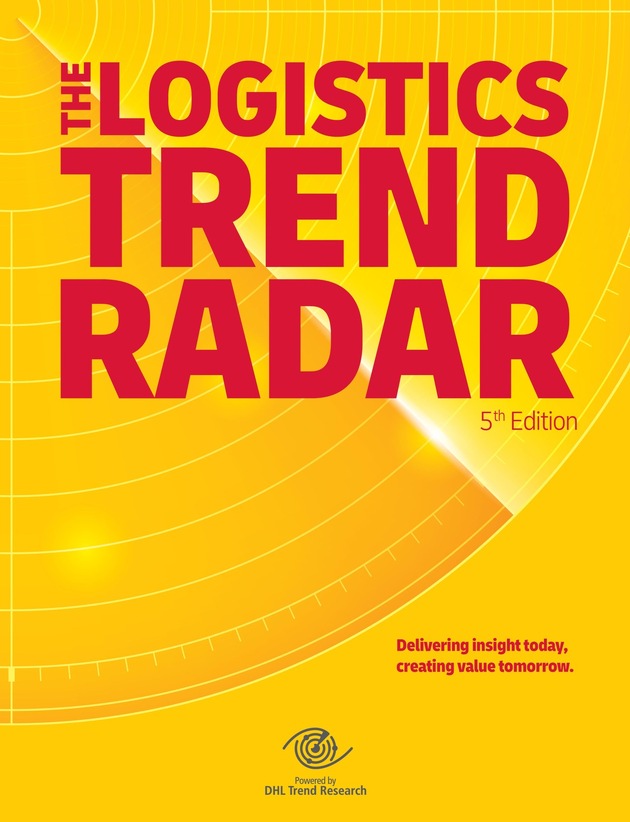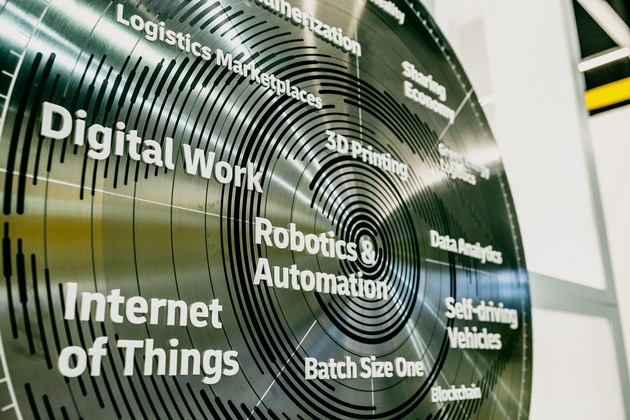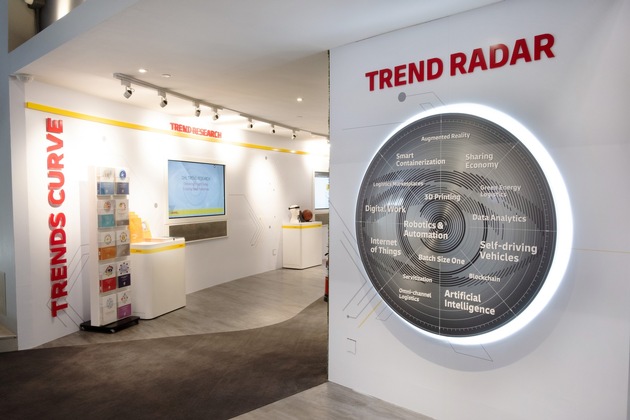PM: DHL Logistics Trend Radar enthüllt Trends, die die Zukunft der Logistik prägen werden
PR: DHL Logistics Trend Radar unveils trends that will shape logistics in the future
Künstliche Intelligenz, Robotertechnik, Quantencomputing, Nachhaltigkeit und globale Volatilität: DHL Logistics Trend Radar enthüllt Trends, die die Zukunft der Logistik prägen werden
- COVID-19 beschleunigt die Digitalisierung und Automatisierung sowie die Entwicklung der zukünftigen Arbeitswelt
- Dynamisches Wachstum in den Bereichen Datenanalytik, künstliche Intelligenz, Robotertechnik, Internet der Dinge, Cloud, und API signalisieren eine neue Normalität für die Logistik
- Bahnbrechende Entwicklungen bei Quantencomputing, Blockchain und Weltraumlogistik eröffnen Logistikanbietern Chancen für neue, großangelegte Lösungen und neue Services
- Nachhaltigkeit ist für alle Branchen ein Muss und erfordert rasche Innovationen für Verpackung, Planung und Optimierung sowie im Gebäudemanagement, um Emissionen zu reduzieren
Bonn, 22. September 2020 - In der fünften Ausgabe des Logistics Trend Radar stellt DHL 29 Schlüsseltrends vor, die die Logistikbranche in den nächsten Jahren beeinflussen werden. Der Bericht ist das Ergebnis einer umfassenden Analyse von Makro- und Mikrotrends und beruht auf Erkenntnissen aus einem großen Partnernetzwerk, das Forschungsinstitute, Technologie-unternehmen, Startups und Kunden umfasst.
"Damit wir unsere Kunden gut beraten können, ist es für uns als Logistikexperten wichtig, zukünftige Herausforderungen zu prognostizieren und mögliche Lösungen zu entwerfen. Die Megatrends, die uns weiterhin beschäftigen werden, sind uns bereits bekannt: neue Technologien, zunehmender E-Commerce und Nachhaltigkeit", sagt Katja Busch, Chief Commercial Officer bei DHL. "Manche Bereiche werden sich jedoch schneller entwickeln als andere. Daher müssen wir die zugrunde liegenden Trends und ihre Auswirkungen auf die Logistik verstehen - nicht zuletzt wegen der Auswirkungen von COVID-19 auf den globalen Handel und die Bevölkerung. Als weltweiter Branchenführer in der Logistik haben wir die nötigen Einblicke und die Expertise, um die Situation zu beurteilen."
In den vergangenen zwei Jahren haben weit über 20.000 Logistik- und Technologieexperten bei Besuchen im DHL Innovation Center ihre Perspektiven für die Zukunft der Branche vorgestellt. Diese Erkenntnisse werden im Logistics Trend Radar gebündelt. Das dynamische und strategische Tool wirft einen Blick in die Zukunft. Es verfolgt Entwicklungen, die in früheren Auflagen aufgezeigt wurden, und stellt in jeder Neuauflage vielversprechende neue Trends vor.
"Die nächste große Herausforderung wird es sein, das Logistikpersonal durch Aus- und Weiterbildung in technologisch immer anspruchsvolleren Betrieben zukunftssicher zu machen. Dies wird in den kommenden Jahren im Mittelpunkt der strategischen Planung von Supply-Chain-Organisationen stehen", sagt Matthias Heutger, Senior Vice President, Global Head of Innovation & Commercial Development bei DHL. "Der Logistics Trend Radar ist ein Seismograph für zukünftige Trends. Auf der Grundlage der Daten der letzten sieben Jahre können wir längerfristige Prognosen erstellen und so unsere Partner und Kunden bei der Erstellung von Roadmaps für ihre Unternehmen unterstützen. Außerdem können wir dabei helfen, weitere branchenführende Forschungen und Innovationen zu strukturieren und auf den Weg zu bringen. In dieser Ausgabe berichten wir, wie Auswirkungen von COVID-19 bereits etablierte Trends beschleunigen. Big Data Analytics, Robotertechnik und Automatisierung sowie das Internet der Dinge (IoT) werden außerdem durch stetige Fortschritte in der künstlichen Intelligenz vorangetrieben.
Beschleunigung von Transformationsprozessen
Die fünfte Ausgabe des Logistics Trend Radar zeigt insgesamt eine Stabilisierung der Trends der letzten vier Jahre. Mit der Bewältigung der aktuellen globalen Pandemie durch die Logistikbranche haben sich die Transformationsprozesse jedoch beschleunigt. COVID-19 hat Innovationen in der Logistik, Automatisierung und digitale Arbeit schneller vorangetrieben und die Digitalisierung der Branche um Jahre beschleunigt. Umgekehrt haben viele Trends, die in der Logistikbranche zunächst als disruptiv galten, sich bislang als gar nicht so disruptiv erwiesen. Autonome Fahrzeuge und Drohnen werden nach wie vor durch gesetzgeberische und technische Herausforderungen sowie durch die geringe gesellschaftliche Akzeptanz gebremst. Die Logistikmarktplätze konzentrieren sich auf einigen wenigen führenden Plattformen. Etablierte Spediteure mit soliden globalen Logistiknetzwerken treten mit eigenen digitalen Angeboten auf den Plan. Von Cloud Computing bis hin zu kollaborativen Robotern, Big Data Analytics, künstlicher Intelligenz und dem Internet der Dinge - Logistiker müssen ein riesiges Spektrum an neuen Technologien zu nutzen wissen. Um heute langfristig Erfolg zu haben, müssen zwingend sämtliche Touchpoints der Lieferketten modernisiert werden. Dies reicht von eleganten digitalen Lösungen für die Kundenerfahrung über den Fulfillment-Transport bis hin zur Lieferung auf der letzten Meile. Anbieter, die sich am schnellsten anpassen, neue Technologien skalieren und ihre Arbeitskräfte qualifizieren, werden einen Wettbewerbsvorteil auf dem Markt haben.
E-Commerce-Wachstum treibt Innovation und Nachhaltigkeit weiter voran
Der E-Commerce nimmt weiter rasant zu, dennoch entfällt auf ihn nur ein Bruchteil der globalen Konsumausgaben. Für den Business-to-Business E-Commerce wird eine ähnliche Entwicklung erwartet. Man geht davon aus, dass sein Volumen drei Mal so groß sein wird wie das des Verbrauchermarkts. Die Coronavirus-Pandemie hat nicht nur das Wachstum des Onlinehandels und Innovationen in der Lieferkette beschleunigt. Entscheidungen über die Skalierung und Einführung neuer Technologien - wie intelligente physische Automatisierung, IoT-gestützte Transparenz-Tools und Prognosefähigkeit durch KI - werden letztlich dafür ausschlaggebend sein, ob Unternehmen die gestiegenen Kundenanforderungen erfüllen und in der Zukunft die Branchenführerschaft sichern können.
Regierungen, Städte und Logistiker verpflichten sich zur Senkung ihrer CO2-Emissionen und Abfälle, und Nachhaltigkeit wird ein Muss für alle Akteure der Logistikbranche. Angesichts der steigenden Nachfrage nach nachhaltigen Lösungen zur Abfallreduzierung, zur Nutzung neuer Antriebstechniken und zur Optimierung von Anlagen ist Nachhaltigkeit auch für die Lieferketten von entscheidender Bedeutung. Heute gibt es mehr als 90 nationale Verbote für Einweg-plastikartikel. Sperrige Verpackungen führen zu 40 Prozent Leerraum in Paketen. Ein Umdenken ist daher unumgänglich. Nachhaltige Lösungen in der Logistik - Optimierung von Prozessen, Materialien, neue Antriebstechniken und intelligente Einrichtungen - bieten ein enormes Potenzial, um die Branche umweltfreundlicher zu machen. Intelligente Containerlösungen werden ebenfalls eine wichtige Rolle spielen, um umweltschonende Konzepte für die Zustellung in verkehrsbelasteten Städten zu entwickeln.
DHL veröffentlicht den Logistics Trend Radar regelmäßig und stellt der globalen Logistikbranche damit ein wichtiges Instrument zur Verfügung. Bei DHL und in der gesamten Branche gilt er als Richtwert für Strategie und Innovation und ist ein wichtiges Tool, um die Richtung spezifischer Trends zu bestimmen - zuletzt waren dies Verpackungslösungen, 5G, Robotertechnik und digitale Zwillinge.
Die fünfte Ausgabe des DHL Logistics Trend Radar, einschließlich ausführlicher Analysen und Informationen zu Projekten, steht unter folgendem Link in englischer Sprache zum kostenlosen Download bereit: www.dhl.com/trendradar
- Ende -
Medienkontakt
Deutsche Post DHL Group
Media Relations
Sabine Hartmann
Tel.: +49 228 182-9944
E-Mail: pressestelle@dpdhl.com
Im Internet: dpdhl.de/presse
Folgen Sie uns: twitter.com/DeutschePostDHL
DHL - The logistics company for the world
DHL ist die weltweit führende Marke in der Logistik. Mit unseren DHL-Divisionen bieten wir ein einzigartiges Logistikportfolio - von der nationalen und internationalen Paketzustellung über Transport- und Fulfillment-Lösungen im E-Commerce, den internationalen Expressversand sowie Straßen-, Luft- und Seefrachttransport bis zum Supply-Chain-Management. Mit rund 380.000 Mitarbeiter*innen in über 220 Ländern und Territorien weltweit verbindet DHL sicher und zuverlässig Menschen und Unternehmen und ermöglicht so globalen nachhaltigen Handel. Mit einer einzigartigen Präsenz in Entwicklungs- und Schwellenländern und spezialisierten Lösungen für Wachstumssektoren wie "Technology", "Life Sciences & Healthcare", "Engineering, Manufacturing & Energy", "Auto-Mobility", und "Retail" ist DHL "The logistics company for the world".
DHL ist Teil des Konzerns Deutsche Post DHL Group. Die Gruppe erzielte 2019 einen Umsatz von mehr als 63 Milliarden Euro. Mit nachhaltigem Handeln sowie dem Engagement für Gesellschaft und Umwelt leistet der Konzern einen positiven Beitrag für die Welt. Bis 2050 strebt Deutsche Post DHL Group die Null-Emissionen-Logistik an.
The logistics company for the world.
____________________________________________________________
Artificial Intelligence, Robotics, Quantum Computing, Sustainability & Global volatility: DHL Logistics Trend Radar unveils trends that will shape logistics in the future
- COVID-19 accelerating digital and automation agendas, as well as future of work
- Dynamic growth in data analytics, artificial intelligence, robotics, IoT, Cloud, API's signal a new normal for logistics
- Breakthroughs in Quantum Computing, Blockchain, and Space Logistics signal new niches for logistics providers to solve large-scale problems and create new services
- Sustainability is a cross-industry imperative, accelerating the need for innovation in packaging, planning, optimization and building management to curb emissions
Bonn, September 22, 2020: In the fifth edition of the Logistics Trend Radar, DHL once more has revealed 29 key trends that will impact the logistics industry over the next years. The Report is the result of an extensive analysis of macro and micro trends, as well as the insights from a large partner network including research institutes, tech players, startups, and customers.
"For us as logistics experts, it is important to forecast the challenges ahead and envision possible solutions so that we may best advise our customers. The mega trends that will continue to engage us are not unfamiliar: new technologies, growing e-commerce and sustainability," says Katja Busch, Chief Commercial Officer, DHL. "But some areas will evolve faster than others, so there is the need to understand the underlying trends and their impact on logistics - not least because of the impact of COVID-19 on global commerce and the entire workforce. As a world leader in logistics, we have the insights and the expertise to evaluate the situation."
Well over 20,000 logistics professionals and technology experts shared their perspectives on the future of the industry when visiting the DHL Innovations Centers over the last two years. The findings are consolidated and reflected on the Logistics Trend Radar which acts as a dynamic and strategic foresight tool that tracks the evolution of trends spotted in past editions, identifying present and future trends with every update.
"The next big challenge will be future proofing the logistics workforce through training and upskilling in increasingly technologically sophisticated operations. This will take center stage on the strategic agendas of supply chain organizations in the years to come," said Matthias Heutger, Senior Vice President, Global Head of Innovation & Commercial Development at DHL. "The Logistics Trend Radar serves as seismograph for future trends. Based on data from the last seven years, we can make longer-term forecasts and thus support our partners and customers to create roadmaps for their business as well as helping to structure and catalyze further industry-leading research and innovations. In this edition, we already see the impact of COVID-19 is accelerating trends that were already well underway - big data analytics, robotics and automation, and IoT, all of which are underpinned by steady progress in artificial intelligence."
Acceleration of transformation processes
The fifth-edition Logistics Trend Radar indicates that we are experiencing an overall stabilization of trends from the past four years. However, with the logistics industry weathering the current global pandemic, transformation processes have been accelerated. COVID-19 has driven changes regarding recent logistics innovation, automation, and digital work more rapidly and has accelerated industry digitalization by years. Conversely, many trends initially perceived as disruptive game-changers for the logistics industry have yet to deliver on their disruptive potential. Self-driving vehicles and drones continue to be held back by legislative and technical challenges as well as limited social acceptance. Logistics Marketplaces are stabilizing on a few leading platforms, and established forwarders are entering the game with their own digital offerings, backed with robust global logistics networks. From cloud computing to collaborative robotics, big data analytics, artificial intelligence, and the Internet of Things, logistics professionals have to make sense of a vast market of novel technology. Modernizing all touchpoints of supply chains, from an elegant digital or customer journey, through fulfillment transport and final mile delivery is the new imperative for long-term success. Those who adopt and scale new technology and upskill workforces fastest, will have a competitive advantage on the market.
E-commerce growth continues to advance innovation and sustainability agendas
E-commerce is still growing rapidly and yet represents only a fraction of global consumer retail spending. Business-to-business e-commerce is expected to follow suit and dwarfs the consumer market size by a factor of three. The coronavirus pandemic has served not only to accelerate both e-commerce growth and supply chain innovation agendas. Key moves to scale and adopt new technology like intelligent physical automation, IoT-powered visibility tools, and predictive capabilities from AI will ultimately determine the ability to fulfill heightened customer demands and secure industry leadership positions in the future.
With governments, cities and solution providers commit to cut down on CO2 emissions and waste, sustainability now is an imperative for the logistics industry. Indicated by the increasing demand on sustainable solutions to reduce waste, leverage new propulsion techniques and optimize facilities, it is also on top of the supply chain agendas. Today, 90+ national bans on single-use plastics exists and bulky packaging causing 40 percent parcel void space, making a rethinking of the packaging inevitable. Sustainable Logistics - optimization of processes, materials, new propulsion techniques, and smart facilities - provide huge potential for logistics to become more environmentally friendly. Smart Containerization in transportation will also be important in developing environmentally friendly formats for delivery in congested cities.
DHL regularly publishes the Logistics Trend Radar as a key instrument for the global logistics community. Both within DHL and across industry, it has become an acclaimed benchmark for strategy and innovation, as well as a key tool to shape the direction of specific trends, most recently packaging, 5G, robotics and digital twins.
The fifth edition DHL Logistics Trend Radar, including information on deep dives and projects, is available for free download at www.dhl.com/trendradar
- End -
Media Contact:
Deutsche Post DHL Group
Media Relations
Sabine Hartmann
Phone: +49 228 182-9944
E-mail: pressestelle@dpdhl.com
On the Internet: dpdhl.de/press
Follow us at: twitter.com/DeutschePostDHL
DHL- The logistics company for the world
DHL is the leading global brand in the logistics industry. Our DHL divisions offer an unrivalled portfolio of logistics services ranging from national and international parcel delivery, e-commerce shipping and fulfillment solutions, international express, road, air and ocean transport to industrial supply chain management. With about 380,000 employees in more than 220 countries and territories worldwide, DHL connects people and businesses securely and reliably, enabling global sustainable trade flows. With specialized solutions for growth markets and industries including technology, life sciences and healthcare, engineering, manufacturing & energy, auto-mobility and retail, DHL is decisively positioned as "The logistics company for the world".
DHL is part of Deutsche Post DHL Group. The Group generated revenues of more than 63 billion euros in 2019. With sustainable business practices and a commitment to society and the environment, the Group makes a positive contribution to the world. Deutsche Post DHL Group aims to achieve zero-emissions logistics by 2050.
The logistics company for the world.
Mit freundlichen Grüßen / With kind regards
Deutsche Post DHL Group



